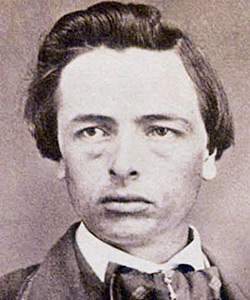Barclay Coppoc (Villard, 1910)
Scholarship
Barclay Coppoc was born at Salem, Ohio, January 4, 1839, and had not attained his majority at the time of the raid. He escaped from Harper's Ferry, but only to meet a tragic fate in that he was killed by the fall of a train into the Platte River from a trestle forty feet high, the supports of which had been burned away by Confederates. Coppoc was then a first lieutenant in the Third Kansas Infantry, Colonel Montgomery's regiment, having received his commission July 24, 1861. Barclay Coppoc went straight to Iowa after his escape from Harper's Ferry, whither Virginia agents followed to attempt his arrest. He went back to Kansas in 1860, helped to run off some Missouri slaves, and nearly lost his life in a second undertaking of this kind. The accident which ended his life took place at night; he survived his injuries until the next day, September 3, 1861. He was buried at Leavenworth, Kansas. He was in Kansas for a time in the fall of 1856.
Oswald Garrison Villard, John Brown, 1800-1859: A Biography Fifty Years After (New York: Houghton Mifflin Company, 1910), 682-683.
Barclay Coppoc (Ohio State Historical and Archeological Society)
Reference
Along with his older brother, Edwin, Barclay was deeply interested in John Brown and his plans, much impressed with the two visits of the old warrior in Springdale, and finally joined the party at Harper's Ferry. While Edwin was commissioned lieutenant, Barclay remained a private. The latter was afflicted with asthma and apparently not sufficiently vigorous to stand up under long continued and arduous physical exertion. For this reason, it is said, he was left on guard at the Kennedy Farm when John Brown and nineteen of his men left on the fateful night of October 16, 1859, to attack Harper's Ferry.
With him were left on guard Owen Brown, son of John Brown, and Francis J. Merriam, a member of the wealthy Merriam family of Massachusetts, whose opposition to slavery led him to join in the movement at Harper's Ferry. Owen had direction of the little party of three who had been instructed by his father to take the arms from the Kennedy house to a school house about one mile from the Ferry, or direct to the Ferry itself, depending upon where they could be used to the best advantage.
With him were left on guard Owen Brown, son of John Brown, and Francis J. Merriam, a member of the wealthy Merriam family of Massachusetts, whose opposition to slavery led him to join in the movement at Harper's Ferry. Owen had direction of the little party of three who had been instructed by his father to take the arms from the Kennedy house to a school house about one mile from the Ferry, or direct to the Ferry itself, depending upon where they could be used to the best advantage.
The Ohio State Historical and Archaeological Society, Ohio Archaeological and Historical Publications (Columbus: Fred J. Herr, 1921), 30: 460.




